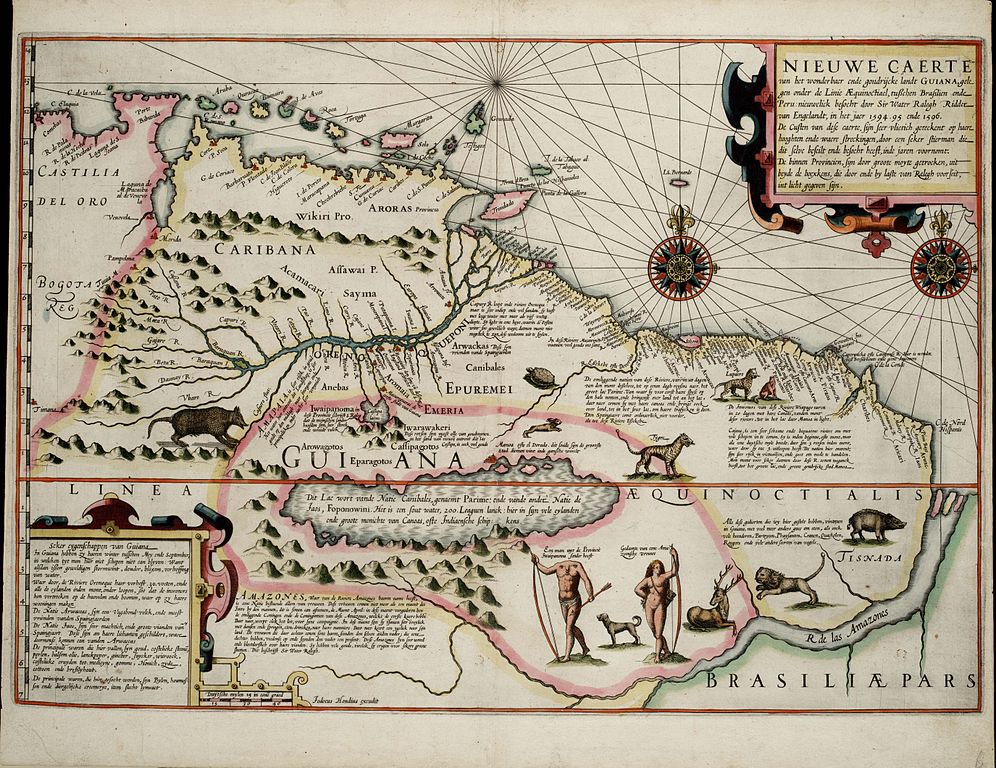
Even in the middle of the 21st century, if we mention 'El Dorado', it refers us to stories of mystery and the hope of finding a city paved with gold and silver. The men of the 16th century, especially an ambitious explorer like Raleigh, were fascinated with the stories of a city of gold in the wild regions of that continent, which still held many unexplored territories.
The origins of El Dorado appear to come from stories brought back by Spanish explorers about 'El Rey Dorado', the golden king of the Muisca people of Colombia, who covered himself in gold dust as part of his initiation, before being cleansed in a sacred lake. Sometime in the 16th century, the story turned from legends of the king to an entire city of gold.
The first reference to a kingdom similar to El Dorado occurred in 1531, when Spanish explorer Diego de Ordaz met a Spaniard who had been held captive by natives for ten years. He spoke of a city of gold, El Dorado or Manoa, which is said to exist beyond a mountain on the banks of the Orinoco River. Ordaz led an expedition, but found the passage impossible and died on the return journey.
Raleigh employed a gifted mathematician and ethnographer, Thomas Harriot, who had been studying Portuguese nautical charts and documents obtained from Pedro Sarmiento de Gamboa, the Spanish governor of Patagonia. These included an account by Juan Martínez de Albujar of visiting a golden city in the desert.
Raleigh had turned forty and was out of favor with the queen after he married Bess Throckmorton, one of her ladies-in-waiting, in 1592 without her permission. He had been imprisoned in the Tower of London, but he persuaded the queen to allow him to lead an expedition to discover El Dorado before the Spanish. Despite his great reputation as an explorer, Raleigh was a poor sailor and frequently seasick. Before leaving Plymouth for the five thousand mile journey to Guyana on February 6, 1595, Raleigh wrote: "I am not so enamored of these long journeys."
Like those before him, Raleigh struck no gold and faced extreme hardship as he made his way up the shallow and inhospitable river. With inadequate provisions and inadequate rowboats, his hundred men endured the jungle heat and tropical rains. Although Raleigh warned his men not to go ashore for fear of "snakes and worms" lurking in the mangroves, morale dropped after a crew member was eaten by a crocodile and they became lost in the river's tributaries.
In his report 'The Discovery of Guyana', presented to the queen on her return, Raleigh offers insight into the difficulties of his expedition to the Orinoco:
The farther we went, our supplies dwindled and the air grew fainter, we grew weaker and weaker, when we most needed strength and skill. For every hour the river rushed more violently than others against us, and Captain Gifford's and Captain Caulfield's barge, barges, and skiff had spent all their stores; just as it drove us to despair and discomfort, if we hadn't persuaded the whole company that it was just one more day's work to get to the land where we would be freed from everything we wanted, and if we came back, we were sure we would we would return. to starve, by the way, and that the world would also laugh at us with contempt. On the banks of these rivers there were various kinds of fruits good for eating, flowers, and trees of such a variety that they were enough to make ten volumes of Herbs; many times we relieved ourselves with the fruits of the country, and sometimes with birds and fish. We saw birds of all colors, some carnations, some crimson, reddish-orange, purple, watchtower (pale blue), and all other kinds, both single and mixed, and it was a great good time for us to pass the time for behold, besides the relief we find in killing some of them with our game; without which, having little or no bread, and less drink, and only the thick, troubled water of the river, we had been in a very difficult case.
Sir Walter Raleigh wrote in his chronicles of the expedition, collected under the name: The Discovery of Guyana, the events that led to the failure of his first expedition. He really believes that in the depths of Guyana there is a kingdom as rich as the one conquered by Francisco Pizarro in Peru, which is ruled by a king who descends from the Incas themselves, which would make El Dorado the last Inca city to be discovered.
The second Raleigh expedition would take place in 1616, years after the death of Queen Elizabeth I. As in the first Raleigh, he was released from prison to command the new expedition that promised the English crown unimaginable riches. Of course the second expedition also failed. Two years later, in 1618, he could no longer escape his fate, he was executed by order of the new English king, James I.
Raleigh's own account presents historians with the usual challenge of separating fact from fiction. He needed to present his failure as something of a success to impress the queen and her investors, such as William Cecil.